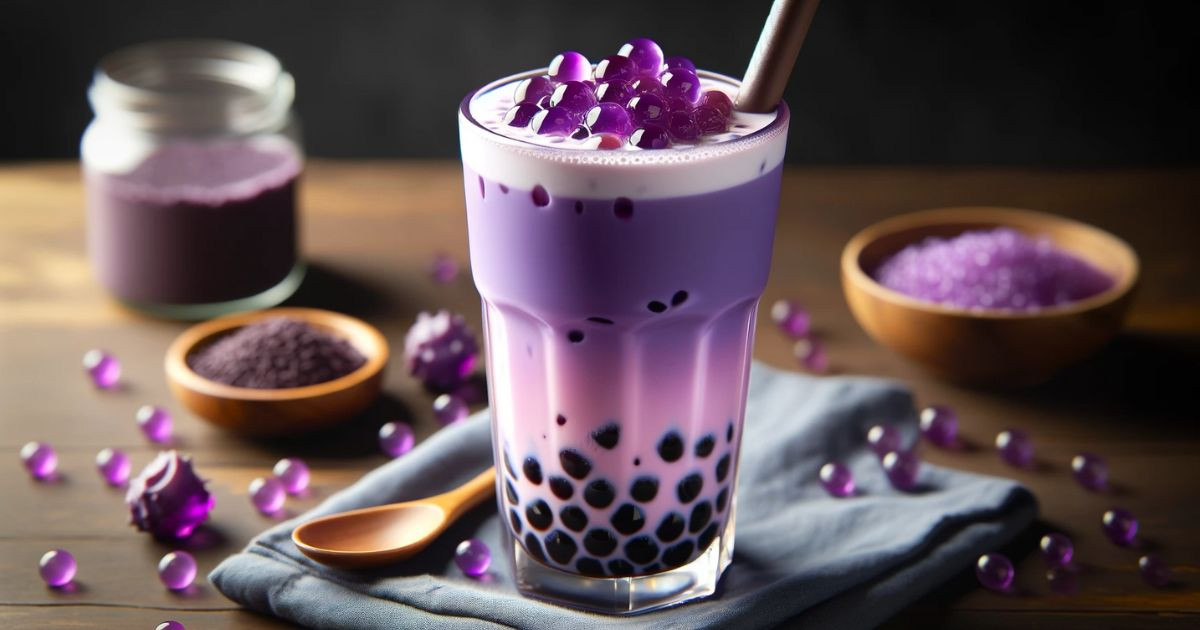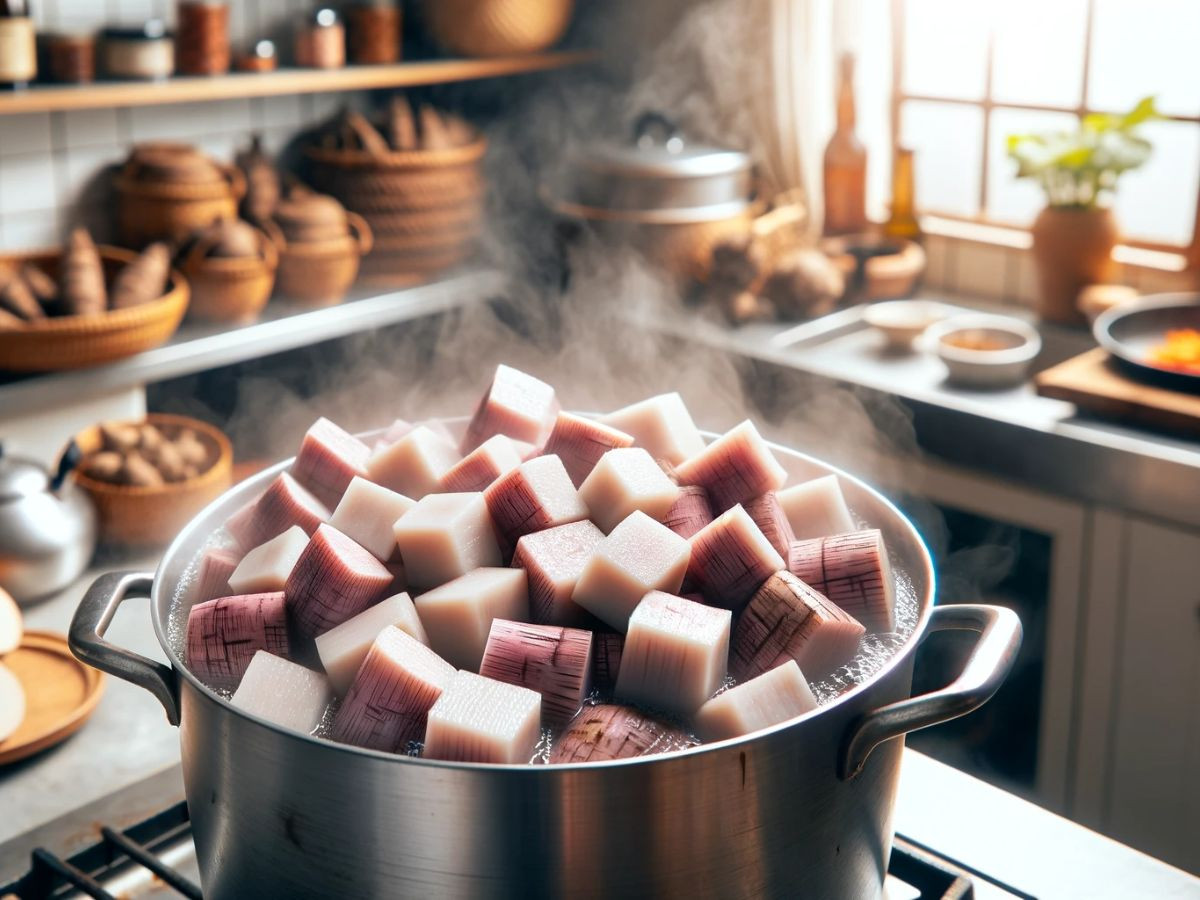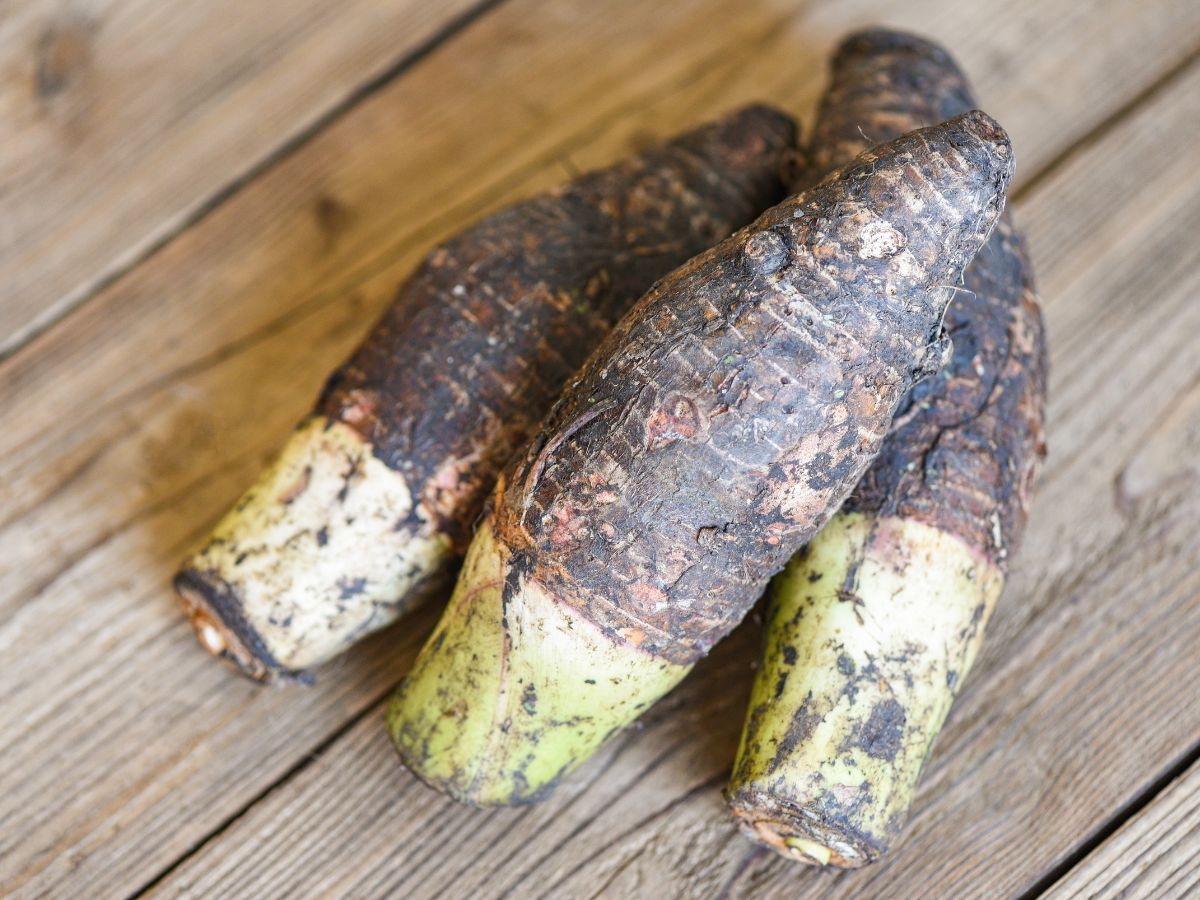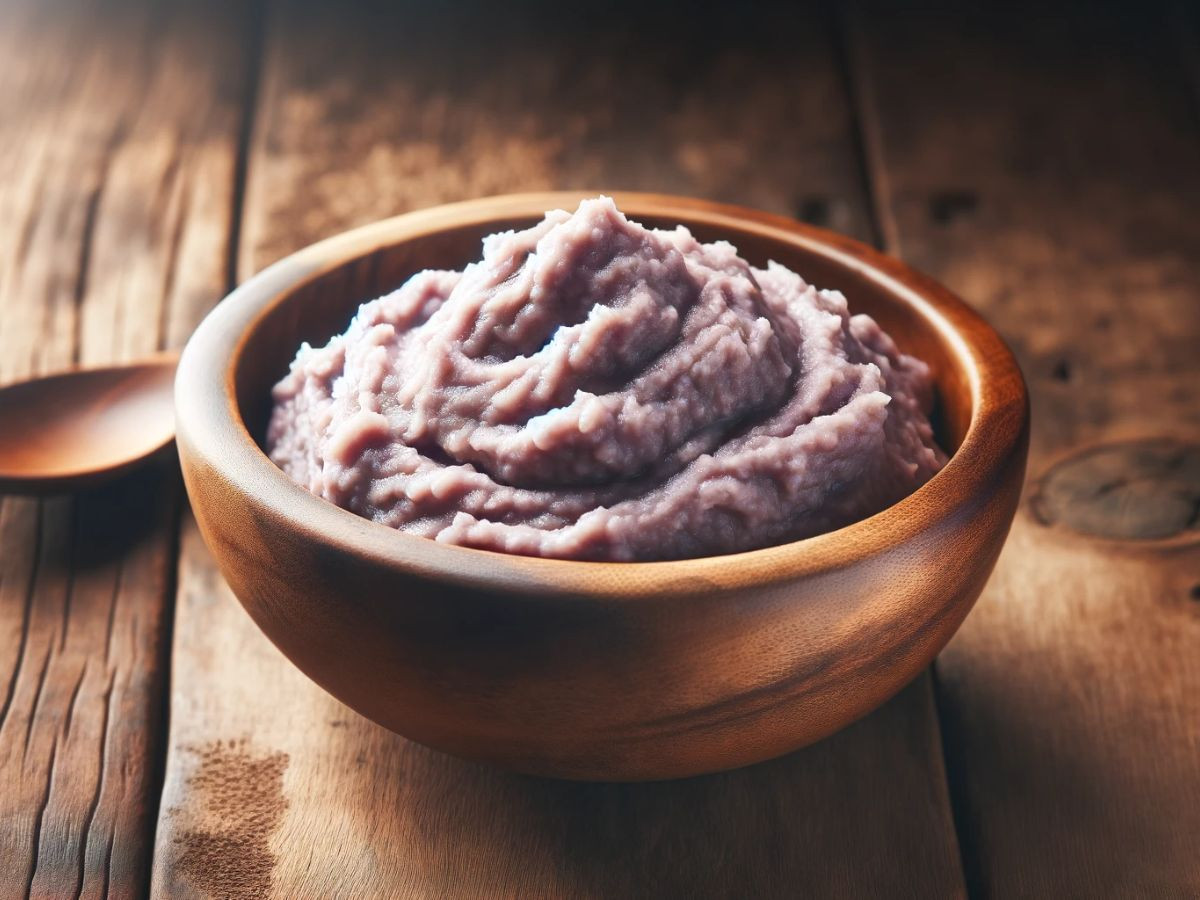Getting Down To The Taro Root and Taro Milk Tea Taste
Whether trying a boba tea for the first time or taro milk, boba tea has been your go-to drink for the past few weeks, and you need help understanding the exact flavor profile that’s confusing your taste buds. We know it’s delicious, and we know it’s a unique root vegetable with many health benefits, but you have to be wondering, What Does Taro Taste Like?

Maybe you cook with Taro root all the time, or perhaps you’ve taken a sip of the increasingly popular taro bubble tea or Taro milk tea and wondered, “What exactly am I tasting?”
I will take you on a taro flavor journey, exploring the unique taste of taro and how it transforms into the delightful taro bubble tea that’s taking the world by storm.
But let me tell you, nothing quite tickles the taste buds like the enigmatic taro root taste.
This humble starchy root vegetable, a staple in many parts of the world, has been a personal favorite of mine, both in the kitchen and as the star ingredient in the ever-popular taro milk tea, with bubble tea shops popping up everywhere.
From its rich history and health benefits to the art of perfecting taro bubble tea, I’ve got you covered. We’ll even throw in a quick recipe for those eager to try their hand at this fascinating ingredient.
So, what does taro taste like? Regarding taro milk tea flavor, taro roots are a bit of a chameleon. It’s sweet yet subtly nutty; think of a cross between a sweet potato and a chestnut.
Its earthiness is reminiscent of a potato, but a whisper of subtle vanilla undertones dances on your palate. And when it’s transformed into taro bubble tea, oh boy, it’s like a cozy, comforting hug in a cup!
Table of Contents
What Does Taro Taste Like?

We will explore the delightful world of taro – from its unique flavor profile to its starring role in the sensational taro bubble tea.
I’ll guide you through making your own taro treats at home. Trust me, once you taste taro powder, there’s no going back!
The Enigmatic Taste of Taro

Let me tell you, the taste of taro is something that always catches my guests by surprise. It’s an enigma wrapped in a brown, hairy exterior. You might expect something potato-like when you get your first taro bubble tea taste, but it’s much more.
Sweet, Nutty, and Uniquely Taro
A Symphony of Flavors: Imagine biting into a dish where sweet meets slightly nutty flavor, with a hint of something you can’t quite put your finger on – that’s raw taro for you. It’s like a sweet potato; a chestnut had a delightful culinary baby.
The Vanilla Whisper: Then, there’s this intriguing whisper of vanilla. It’s subtle, but it adds a depth that transforms any dish. This is what makes taro so special in desserts and sweet beverages.
Comfortingly Starchy: And the texture! Taro brings a comforting, creamy starchiness that’s heartier and more satisfying than your average potato. This quality makes taro a go-to ingredient for chefs looking to add substance and depth to their dishes.
Taro’s Culinary Ballet
Savory or Sweet? Both!: I’ve used taro in the kitchen, from hearty stews to delicate pastries. Its ability to complement savory and sweet ingredients is culinary magic.
The Star in Bubble Tea: But where taro truly shines is in bubble tea. It’s what makes taro milk tea purple and taro bubble tea healthy. The creamy texture and sweet and nutty flavor harmonize with the tapioca pearls’ playful chewiness.
Taro: A Root with a Rich Tapestry of History

Taro’s history is as fascinating as its taste. This humble root has a legacy that’s as rich and complex as its flavor.
A Journey Through Time and Cultures
Ancient Roots: Taro has been nourishing civilizations for thousands of years. Originating in Southeast Asia and India, it’s a staple that has stood the test of time.
Cultural Keystone: In places like Hawaii and across Polynesia, taro is more than food; it’s a cultural cornerstone. The famous Hawaiian dish ‘poi,’ made from fermented taro, is a testament to its significance.
Taro’s Global Footprint
Beyond Borders: The beauty of taro lies in how it has traversed borders and oceans. Today, it’s celebrated in cuisines worldwide, from the taro balls in Taiwanese desserts to the flavorful curries in Indian kitchens.
A Symbol of Resilience: What strikes me most about taro is its resilience. It grows in diverse climates, symbolizing adaptability and endurance – qualities we chefs admire in a good ingredient.
The Story in Every Bite
More than Just a Flavor: I’m reminded of this rich history whenever I cook with taro or sip on a taro tea. It’s not just about the flavor; it’s about participating in a tradition that spans continents and centuries.
The Health Benefits of Taro

This root vegetable packs a punch in terms of health benefits, too. It’s one ingredient that makes you feel good about indulging in your foodie passions.
A Nutrient Powerhouse
Rich in Fiber: Taro is an excellent source of dietary fiber, crucial for digestive health. Including it in your diet can mean better digestion and a happier gut.
Vitamins and Minerals Galore: Packed with essential nutrients like vitamins C, E, potassium, and magnesium, taro supports overall health, from boosting the immune system to maintaining healthy skin.
A Friend to Your Health Goals
Low Glycemic Index: For those watching their blood sugar, taro is an excellent choice. Its low glycemic index means it won’t cause rapid spikes in blood sugar levels.
Heart-Healthy: The fiber in taro also plays a role in heart health, helping to lower cholesterol levels and reduce the risk of heart disease.
The Perfect Blend of Taste and Wellness
A Healthy Twist in Dishes: Incorporating taro into dishes is an easy way to add nutritional value without compromising taste. Whether in a savory curry or a sweet bubble tea, you’re getting a dose of good health.
Balancing Flavor and Nutrition: I love that taro blends its unique flavor with its health benefits, making it a fantastic ingredient for tasty and health-conscious recipes.
Taro in the Culinary World: Versatility at Its Best

Taro’s charm in the culinary world lies in its incredible versatility. This starchy root can be transformed into many dishes, each revealing a different aspect of its unique flavor profile.
From Savory to Sweet: Taro Does It All
Savory Delights: In savory dishes, taro brings a depth of flavor and a satisfying texture. It’s fantastic in stews, where it absorbs the flavors of the broth, or in stir-fries, adding a delightful contrast.
Sweet Creations: In sweet dishes, taro takes a different turn. It adds a creamy, rich dimension to desserts. Think taro pastries or puddings, where its subtle sweetness shines through.
The Art of Cooking Taro
Boiled or Fried? Both!: Boiling taro brings out its natural sweetness and soft texture, making it ideal for mashes or fillings. Frying, on the other hand, adds a crispy dimension, perfect for snacks like taro chips.
The Secret to Perfect Taro: The key to cooking taro perfectly is understanding its texture. It should be cooked until soft but not mushy, retaining its shape and bite.
Taro Bubble Tea: A Modern Twist
The Star Ingredient: This root takes center stage in taro bubble tea. The creamy texture and sweet, nutty flavor of taro blend seamlessly with the tea and milk, creating a beverage that’s both refreshing and comforting.
A Cult Favorite: The popularity of taro bubble tea speaks to taro’s versatility. A modern twist has introduced this traditional ingredient to a whole new audience.
Celebrating Taro’s Culinary Range
An Ingredient for All Seasons: Whether you’re whipping up a hearty winter meal or a refreshing summer drink, taro is an ingredient that adapts to the occasion.
A Canvas for Creativity: For culinary enthusiasts, taro offers a canvas to experiment with flavors and textures, making it a favorite in kitchens worldwide.
Mastering Taro Bubble Tea: A Step-by-Step Guide

With its unique flavor and captivating purple hue, Taro bubble tea is a surprisingly simple crowd-pleaser to make at home. Here’s how you can bring this delightful beverage into your kitchen.
Ingredients You’ll Need
Taro: Fresh taro root is ideal, but taro powder is a quicker alternative.
Tea: Black or green tea forms the base of the drink.
Milk: Choose from dairy or plant-based options to suit your preference.
Sweetener: Sugar, honey, or any sweetener of your choice.
Tapioca Pearls: These chewy pearls are essential for that authentic bubble tea experience.
Preparing the Taro
Peel and Dice: Start by peeling the taro root and cutting it into small cubes. This ensures even cooking.
Boil Until Tender: Boil the taro cubes until they’re tender. This usually takes about 15-20 minutes.
Mash or Blend: Once boiled, you can either mash the taro for a more rustic texture or blend it for a smoother consistency.
Brewing the Tea
Steep the Tea: Brew your choice of tea—stronger is better as it’ll be diluted with milk and ice.
Cool it Down: Let the tea cool to room temperature or chill it in the refrigerator.
Assembling the Taro Bubble Tea
Cook the Tapioca Pearls: Follow the package instructions to cook the tapioca pearls. Once cooked, rinse them under cold water and sweeten them with sugar or honey.
Mix Taro with Milk: Combine the mashed or blended taro with milk, adjusting the ratio to your taste preference.
Add Sweetener: Sweeten the taro and milk mixture to your liking.
Layer the Drink: Start with tapioca pearls at the bottom of the glass, pour in the taro milk mixture, and then top it with the brewed tea.
Final Touch: Give it a good stir, add ice if desired, and there you have it—homemade taro bubble tea!
Tips for the Perfect Taro Bubble Tea
Balance is Key: The secret to an excellent taro bubble tea is balancing the flavors. Adjust the sweetness and the strength of the tea to complement the creamy taro.
Experiment with Textures: Play around with the texture of the taro. Some prefer it chunkier, while others love it silky smooth.
Serve Immediately: Taro bubble tea is best enjoyed fresh, so serve it right after assembling it for the best taste and texture.
Conclusion: Embracing the Versatility of Taro
Taros, from a staple in ancient civilizations to a trendy ingredient in modern cafes, is a testament to its enduring appeal.
Taro’s unique taste—a harmonious blend of sweet, nutty, and creamy notes—makes it versatile in traditional and contemporary recipes.
From comforting stews to the playful and popular taro bubble tea, taro root or taro powder has proven to adapt and shine in various culinary contexts.
Its nutritional benefits make it a wise choice for those seeking a healthy yet satisfying ingredient. It’s a beautiful blend of flavor, health, and history.
FAQ And Additional Information
Does Taro Taste Like Coconut?
Taro does not typically taste like coconut. While taro and coconut are staples in tropical cuisines and can be found in similar dishes, their flavors are distinct.
Taro is known for its nutty and slightly sweet flavor. When cooked, it’s often compared to sweet potatoes or yams, with a hint of vanilla-like sweetness and a starchy, creamy texture. This unique flavor profile makes taro a versatile ingredient in savory and sweet dishes.
On the other hand, coconut has a distinctly tropical flavor that is sweet and somewhat nutty, but it also carries a creamy richness and a fragrance that is unmistakably coconut.
It’s used in various culinary applications, from coconut milk and oil to shredded coconut and coconut water, each imparting its signature tropical taste.
While they share a mild sweetness and a creamy texture in some preparations, the flavors of taro and coconut are pretty different and recognizable in their own right.
Is Taro Sweet or Savory?
Taro is a unique ingredient because it can be sweet and savory, depending on how it’s prepared. The natural flavor of taro root is mildly sweet and nutty, making it versatile and adaptable to a wide range of dishes.
Savory Applications:
In savory dishes, taro is often used similarly to potatoes. It can be boiled, baked, fried, or mashed and is commonly found in stews, curries, and as a side dish.
In these preparations, its natural sweetness is subtle and complements the savory flavors of the dish.
Sweet Applications:
Taro is also used in sweet dishes, especially in Asian cuisines. It can be made into sweetened dessert fillings and puddings and even incorporated into ice creams or sweet drinks like bubble tea.
Its natural sweetness is enhanced in these cases, and the taro contributes a creamy, rich texture.
So, taro’s flavor profile allows it to bridge the gap between sweet and savory, making it a versatile ingredient in the culinary world.







